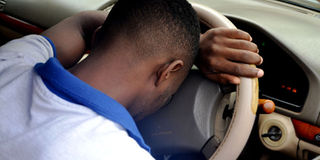Dealing with medical emergencies on the road

Experts insist that if you notice someone in distress, you should only try to help if you can. You should not risk being knocked by an oncoming vehicle as you try to help. PHOTO BY Gabriel Buule
What you need to know:
We should always do our best to be prepared to respond to any emergency. Even though we may not be medical professionals there is some assistance we can offer with first aid and effective and fast response to emergencies
Medical emergencies can be compared to rain. They in most cases happen unannounced, anywhere and at any time of the day or night. As a motorist or as a passenger, what is important is to be ready for anything, or be ready to offer help to someone in need.
At the start of this year, Leah Kansiime boarded a taxi in Kayunga destined for Kampala. Along the way, her neighbour said she was unwell. She did not pay much attention to this until the neighbour placed her head on the taxi seat. A few minutes later, the neighbour started vomiting. Kansiime then called out to the driver and conductor informing them of a passenger who needed urgent help.
“I searched the woman’s handbag and found her phone. It was not locked and I checked through the contacts list and called the number I realised she called often. When it was answered, I informed the person what had happened. Fortunately, it was the sister and I directed her to Mirembe Medical Centre in Gayaza where the taxi driver had dropped her off,” Kansiime recalls, adding that the other passengers had already disembarked because they could not bear with the situation.
Dr Umarashid Gulooba of Makerere University says the kind of medical emergency to deal with in traffic jam or on the road is dependent on the type or how it occurs. However, the most common ones are fainting, becoming dizzy, labour pains for expectant mothers, suffocation during hot days and heart attacks.
Fainting
“If you faint or when one of your passengers faints, look for a bigger place to park and retrieve the victim from the car. Lay them on their back in a flat area so that blood can flow to all parts of the body as you fan them with a cloth or paper,” Gulooba advises.
“To reduce the chance of fainting again, do not get the person up too quickly. Give them room temperature water as you look around for the nearest health centre for advanced medical attention,” Gulooba adds.
Suffocation
The most common cause of suffocation is shortage of fresh air for breathing. By the time you suffocate, it means your lungs are short of or have run out of natural air. Motorists who are at a higher risk of suffocating are those whose windows are always raised up and use car air conditioners constantly. It is also caused by irritating gases, especially those from carbonated drinks such as soda. Your car AC will play the primary role of keeping you and the car interior cool but it produces a lot of artificial air yet your breathing system needs more natural air.
“What is important is to place the victim in an open place so that their lungs can take in natural air. If they are in the open and they have not gained their consciousness, apply mouth to mouth first aid to blow or pump air to open and decongest their lungs,” Dr Gulooba advises.
Henry Musinguzi, a general physician at Nyakibaale Referral Hospital, recommends daily exercise as one of the ways to prevent suffocation. This is because exercises such as swimming and yoga involve constant breathing to relieve your lungs of stress, one of the causes of suffocation.
Heart attacks
Most heart attacks show signs and symptoms through chest pain and discomfort in the chest area, dizziness and uncalled for sweating. While it is common in adults, Dr Musinguzi says heart attacks can also happen in children. However, when it comes to children, it may at times be hard to tell because they may not be able to describe the feeling as an adult would.
“Find a flat area and apply cardiopulmonary resuscitation on the victim if they are unconscious. This involves carrying out chest compressions with both hands to keep blood and oxygen flowing in the victim’s body,” Musinguzi explains, advising that if you or anyone in your car shows signs of a heart attack, the best thing to do before they faint or lose their breath is drive to the nearest health centre for medical attention.
First aid kit
We spend a lot of time on the road – on our way to and from work, visiting friends, shopping, or going on holiday. But often there are times when drivers are on the road in unfavourable conditions and accidents happen when you least expect them, so it’s always good to be prepared and have a first aid kit in your car.




